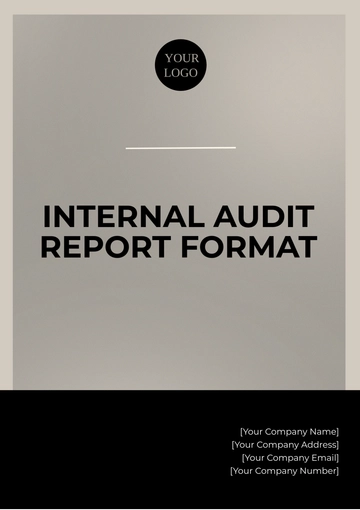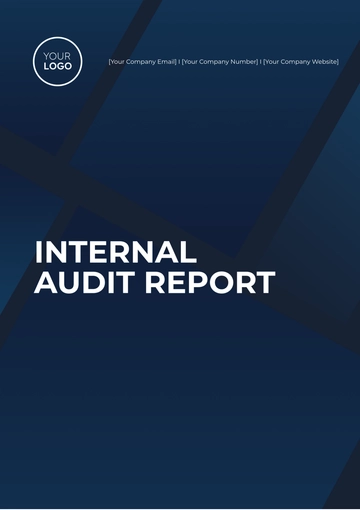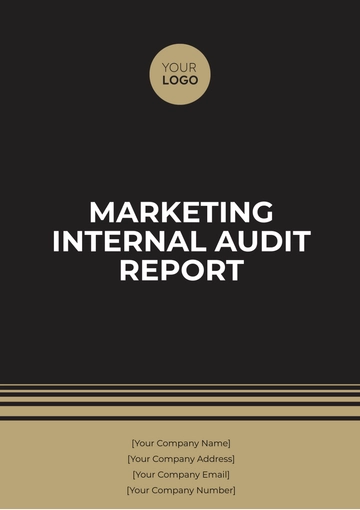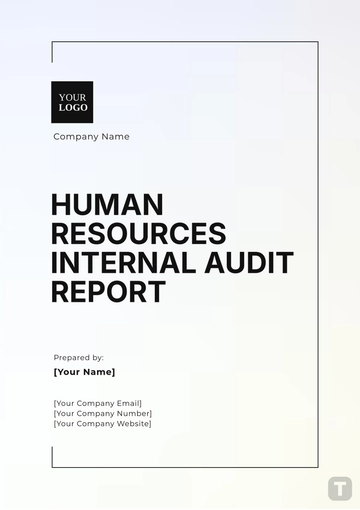Free Bank Internal Audit Report

I. Executive Summary
A. Purpose of the Audit
The purpose of this internal audit was to assess the effectiveness of the internal controls, risk management processes, and compliance with regulatory requirements at [Your Company Name]. The audit focused on the bank's operations, financial reporting, and overall governance framework. The review was conducted to ensure that the bank's operations were aligned with industry standards and regulatory requirements.
B. Key Findings
The audit identified several areas of improvement, particularly in the bank’s internal control systems and compliance with emerging cybersecurity regulations. Significant risks were identified in the area of financial reporting, where certain procedures did not fully align with best practices. Additionally, the audit found that the risk management framework required enhancements in terms of monitoring and reporting.
C. Overall Conclusion
While [Your Company Name] maintains a strong internal control environment overall, several gaps in operational efficiency and compliance with regulations were identified. Immediate attention is recommended to address these gaps. The bank’s overall risk management processes are sound but require strengthening in specific areas, such as cybersecurity and compliance reporting.
D. Summary of Recommendations
It is recommended that [Your Company Name] implement stronger internal controls, particularly in its financial reporting and cybersecurity practices. Management should prioritize the completion of the outstanding compliance requirements and enhance the risk assessment framework. We also recommend regular training for staff to stay current with regulatory changes.
II. Introduction
A. Background Information
[Your Company Name] is a global banking institution offering a wide range of financial services to individuals and businesses. With over 100 branches worldwide, the bank has experienced significant growth in recent years. This audit was part of the routine annual review of the bank’s operations and control systems.
B. Audit Objectives
The primary objectives of the audit were to assess the effectiveness of internal controls, evaluate the risk management practices, and determine compliance with applicable laws and regulations. We also sought to identify any inefficiencies in operations and suggest improvements. A secondary goal was to assess the effectiveness of the bank’s IT systems, particularly in terms of data protection and cybersecurity.
C. Scope of the Audit
The audit covered the financial year 2049-2050 and focused on areas including financial reporting, operational processes, risk management, and compliance with key regulations such as anti-money laundering (AML) and data protection. A detailed review of IT security and the bank's response to emerging risks was also included.
D. Audit Methodology
The audit methodology included interviews with key personnel, document reviews, data sampling, and testing of financial transactions. We also conducted a comprehensive risk assessment, focusing on the most critical areas of concern. Benchmarking was carried out against industry standards and best practices.
E. Limitations of the Audit
The audit was limited by the availability of certain internal data and the bank’s ongoing efforts to update its IT systems. We were unable to conduct a full audit of some subsidiary operations due to time constraints. However, these limitations did not affect the overall scope of the audit.
III. Audit Scope and Approach
A. Areas Reviewed
Financial Reporting and Controls
The audit reviewed the accuracy and reliability of the bank's financial statements, focusing on the general ledger and financial reporting processes. We found minor discrepancies in the month-end closing procedures that need to be addressed. Overall, the financial reporting controls were functioning well, though some areas of improvement were identified.
Risk Management Processes
The risk management framework was assessed to determine its effectiveness in identifying, assessing, and mitigating key risks. We found that the bank's risk management processes were well-defined but lacked adequate risk reporting mechanisms for cybersecurity. Enhancements to risk identification processes were recommended to address emerging risks in financial operations.
Compliance with Regulatory Requirements
A review of compliance with key regulations such as the Anti-Money Laundering Act, Basel III, and GDPR was conducted. We identified a few instances where the bank’s compliance procedures were not fully aligned with the latest updates in data privacy regulations. A more robust compliance training program for staff is recommended.
Operational Processes
Operational procedures were reviewed to ensure the bank’s processes were efficient and cost-effective. While most operational areas are well-managed, a lack of standardized processes in loan origination was identified. Improvements in process automation and staff training could enhance efficiency.
B. Audit Techniques
Data Testing and Sampling
We performed a statistical sampling of financial transactions to test the accuracy of reporting and compliance with financial controls. The sample size was selected to cover all major transaction types. The testing confirmed the reliability of financial records but highlighted discrepancies in certain minor transaction categories.
Interviews and Surveys
Interviews were conducted with senior management, risk officers, and department heads to understand internal control processes. Staff surveys were also used to assess the level of awareness regarding internal controls and compliance regulations. The responses showed a general awareness of key issues, though further training is necessary.
Document and Process Review
The audit team reviewed key documents, including financial statements, risk management reports, and compliance records. We also examined standard operating procedures (SOPs) for various departments. The review revealed areas where documentation needs to be updated to reflect current operational practices.
External Benchmarking (if applicable)
We benchmarked key operational and financial metrics against industry standards, particularly in the areas of risk management and cybersecurity. This helped identify areas where [Your Company Name] was performing well and areas requiring improvement. External benchmarking revealed that the bank lagged behind competitors in cybersecurity preparedness.
IV. Detailed Findings
A. Internal Controls
Control Environment
The control environment at [Your Company Name] is generally strong, with a clear organizational structure and strong management oversight. However, there are occasional lapses in enforcing control protocols in the lower levels of the organization. Increased monitoring is recommended to ensure adherence to controls.
Control Activities
Control activities, including approval processes and segregation of duties, are well-established. However, there are occasional delays in processing approvals due to system inefficiencies. Automation of approval workflows is recommended to reduce delays and improve overall efficiency.
Monitoring Activities
Ongoing monitoring activities are in place, but the frequency and scope of audits could be expanded to ensure timely identification of control failures. Implementing more frequent spot checks and automated monitoring tools will improve effectiveness. Regular monitoring reports should be made available to senior management.
V. Risk Assessment
Risk Area | Likelihood | Impact | Current Mitigation | Recommendation |
|---|---|---|---|---|
Cybersecurity Risk | High | High | Security Protocols | Enhance security training for employees |
Financial Reporting | Medium | High | Quarterly Reviews | Improve reconciliation procedures |
Compliance Gaps | Medium | Medium | Periodic Audits | Strengthen compliance monitoring systems |
VI. Conclusions
A. Summary of Audit Findings
The audit findings indicate that [Your Company Name] has a strong internal control environment, but there are critical gaps in several areas that need attention. While internal controls over financial reporting are generally well-established, issues were identified in the reconciliation processes that need further refinement. The audit also highlighted areas for improvement in cybersecurity protocols, as well as a need for more rigorous compliance monitoring systems. These findings suggest that while the bank is performing well overall, the implementation of the recommended improvements will ensure stronger resilience against emerging risks.
B. Assessment of Internal Control Effectiveness
Internal controls at [Your Company Name] are largely effective, with a solid framework in place for monitoring and overseeing operations. However, there are certain areas where controls can be enhanced, particularly in low-level operational procedures and documentation, which have shown inconsistencies across branches. The control environment is robust at the senior management level but needs further reinforcement at the operational levels, especially with regard to approval processes. Strengthening these areas will lead to a more comprehensive and effective control environment across all tiers of the organization.
C. Overall Risk Management and Compliance Standing
The bank’s risk management framework is well-defined but requires updating to align with current and future risk landscapes. While the bank excels in traditional risk areas, it is falling short in emerging sectors, particularly cybersecurity, where external benchmarks indicate that [Your Company Name] lags behind industry standards. Compliance with regulatory requirements remains mostly robust, but minor gaps were found in adherence to evolving data privacy regulations. A thorough review of the bank’s compliance strategy is necessary to close these gaps and safeguard against future regulatory changes.
D. Areas of Strength and Weakness
[Your Company Name] demonstrates a strong commitment to internal controls and regulatory compliance, with notable strengths in financial reporting and operational oversight. However, weaknesses exist in areas such as the timeliness of financial reconciliations and the management of emerging cybersecurity risks. Additionally, operational processes, while effective, could benefit from further automation to streamline workflows. Addressing these weaknesses will improve efficiency, enhance risk management, and ensure long-term regulatory compliance.
VII. Recommendations
A. Immediate Actions Required
Cybersecurity Improvements | It is crucial that [Your Company Name] urgently updates its cybersecurity protocols, focusing on both preventive measures and response strategies. This includes the implementation of more frequent vulnerability scans, enhanced employee training on phishing attacks, and the adoption of the latest encryption technologies. |
Financial Reconciliation Procedures | The bank should expedite the revision of its month-end reconciliation processes to address inconsistencies and delays. Ensuring that all branches follow a standardized process will significantly reduce errors and improve the timeliness of financial reports. |
Regulatory Compliance Monitoring | The bank should immediately update its compliance monitoring system to address recent changes in global data protection regulations, particularly GDPR. A dedicated compliance officer should be assigned to track and implement regulatory changes to avoid any potential non-compliance. |
B. Long-term Improvements and Strategic Recommendations
Risk Reporting Enhancements | It is recommended that the bank implement a centralized risk reporting system that provides real-time updates on risk exposure across all departments. This system should be integrated with the bank's existing software to ensure seamless data flow and accurate risk assessments. |
Automation of Operational Processes | The bank should invest in automating low-level operational processes, particularly in loan origination and transaction approval. This will reduce human error, speed up operations, and enable employees to focus on higher-value tasks. |
Strengthened Compliance Training Program | A comprehensive training program should be developed and delivered regularly to all employees, ensuring that they are up-to-date with current regulatory requirements. The program should include specific modules on anti-money laundering (AML), data privacy, and ethical standards. |
C. Prioritization of Recommendations (High, Medium, Low)
High Priority | Cybersecurity improvements, including staff training and system upgrades, and the revision of financial reconciliation procedures. |
Medium Priority | The development of a centralized risk reporting system and the automation of operational processes, particularly loan origination. |
Low Priority | Strengthening compliance training and revising the monitoring system for regulatory compliance. |
VIII. Management's Response
A. Summary of Management's Comments
Management of [Your Company Name] acknowledges the audit findings and agrees with the importance of addressing the identified gaps in cybersecurity, financial reporting, and regulatory compliance. They have expressed commitment to implementing the recommendations and are already taking steps toward strengthening the cybersecurity framework and updating reconciliation procedures. Management also plans to review the bank’s compliance practices and adjust them to ensure they are aligned with the latest regulatory developments.
B. Actions Taken or Planned to Address Audit Findings
Management has already initiated a review of its cybersecurity protocols, focusing on the installation of advanced firewall technologies and enhanced staff awareness programs. The financial reconciliation process has been assigned to a dedicated task force to streamline and standardize procedures across branches. Additionally, management is in the process of hiring a new compliance officer to ensure more rigorous adherence to data protection and financial regulations. These actions will be tracked and reviewed quarterly.
C. Timeline for Completion of Actions
Management has committed to the following timelines for addressing the findings:
Cybersecurity Updates: Completion by the end of Q2 2050.
Financial Reconciliation Improvements: Completion by the end of Q3 2050.
Compliance Monitoring Enhancements: Completion by the end of Q2 2050.
Training Programs: Initiation of the first phase by Q4 2050.
D. Commitment to Continuous Improvement
Management is dedicated to fostering a culture of continuous improvement and recognizes the importance of regular audits to assess the effectiveness of implemented changes. The bank’s leadership team is committed to creating a more secure, efficient, and compliant environment, ensuring that [Your Company Name] remains resilient against future risks and regulatory challenges.
- 100% Customizable, free editor
- Access 1 Million+ Templates, photo’s & graphics
- Download or share as a template
- Click and replace photos, graphics, text, backgrounds
- Resize, crop, AI write & more
- Access advanced editor
The Bank Internal Audit Report Template from Template.net is the ideal solution for professionals looking for a comprehensive and customizable audit report. Fully editable and tailored to your specific needs, this template allows you to create accurate, professional reports effortlessly. With the AI Editor Tool, you can easily personalize every section, ensuring efficiency and precision.
You may also like
- Sales Report
- Daily Report
- Project Report
- Business Report
- Weekly Report
- Incident Report
- Annual Report
- Report Layout
- Report Design
- Progress Report
- Marketing Report
- Company Report
- Monthly Report
- Audit Report
- Status Report
- School Report
- Reports Hr
- Management Report
- Project Status Report
- Handover Report
- Health And Safety Report
- Restaurant Report
- Construction Report
- Research Report
- Evaluation Report
- Investigation Report
- Employee Report
- Advertising Report
- Weekly Status Report
- Project Management Report
- Finance Report
- Service Report
- Technical Report
- Meeting Report
- Quarterly Report
- Inspection Report
- Medical Report
- Test Report
- Summary Report
- Inventory Report
- Valuation Report
- Operations Report
- Payroll Report
- Training Report
- Job Report
- Case Report
- Performance Report
- Board Report
- Internal Audit Report
- Student Report
- Monthly Management Report
- Small Business Report
- Accident Report
- Call Center Report
- Activity Report
- IT and Software Report
- Internship Report
- Visit Report
- Product Report
- Book Report
- Property Report
- Recruitment Report
- University Report
- Event Report
- SEO Report
- Conference Report
- Narrative Report
- Nursing Home Report
- Preschool Report
- Call Report
- Customer Report
- Employee Incident Report
- Accomplishment Report
- Social Media Report
- Work From Home Report
- Security Report
- Damage Report
- Quality Report
- Internal Report
- Nurse Report
- Real Estate Report
- Hotel Report
- Equipment Report
- Credit Report
- Field Report
- Non Profit Report
- Maintenance Report
- News Report
- Survey Report
- Executive Report
- Law Firm Report
- Advertising Agency Report
- Interior Design Report
- Travel Agency Report
- Stock Report
- Salon Report
- Bug Report
- Workplace Report
- Action Report
- Investor Report
- Cleaning Services Report
- Consulting Report
- Freelancer Report
- Site Visit Report
- Trip Report
- Classroom Observation Report
- Vehicle Report
- Final Report
- Software Report





























